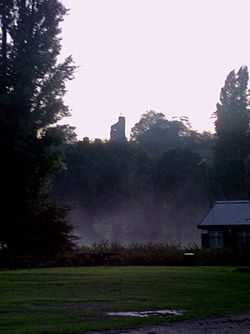Tutbury
| Tutbury | |
 Tutbury | |
| OS grid reference | SK211285 |
|---|---|
| District | East Staffordshire |
| Shire county | Staffordshire |
| Region | West Midlands |
| Country | England |
| Sovereign state | United Kingdom |
| Post town | BURTON-ON-TRENT |
| Postcode district | DE13 |
| Dialling code | 01283 |
| Police | Staffordshire |
| Fire | Staffordshire |
| Ambulance | West Midlands |
| EU Parliament | West Midlands |
| UK Parliament | Burton |
| |
Tutbury is a large village and civil parish of about 3,000 residents in the English county of Staffordshire.
It is surrounded by the agricultural countryside of both Staffordshire and Derbyshire. The site has been inhabited for over 3000 years, with Iron Age defensive ditches encircling the main defensive hill, upon which now stands ruins of a Norman castle. These ditches can be seen most clearly at The Park pale and at the top of the steep hills behind Park Lane.


The name Tutbury probably derives from a Scandinavian settler and subsequent chief of the hill-fort, Totta, bury being a corruption of burh the Anglo-Saxon name for 'fortified place'. It is 5 miles north of Burton upon Trent and 20 miles south of the Peak District.
Quarries near Tutbury once produced alabaster which was used in the carving of Nottingham Alabaster.
Until 2006, Tutbury Crystal, a manufacturer of high-quality cut glass products, was based in the village—however production transferred to Stoke-on-Trent as the existing factory was very old and was thought to be too small for the modern company's requirements. The old factory was demolished and apartments are built on the site, but a factory shop still operates in the village however. Despite this, the tourism trade survives thanks to the long and distinguished history of the Norman Priory Church and medieval Tutbury Castle where Mary, Queen of Scots, was once imprisoned.
Tutbury Castle became the headquarters of Henry de Ferrers and was the centre of the wapentake of Appletree, which included Duffield Frith. With his wife Bertha, he endowed Tutbury Priory with two manors in about 1080. It would seem that Tutbury at that time was a dependency of the Norman abbey of St Pierre‑sur‑Dives.[1] One of the Royal Studs was established in the area round the castle by Henry VIII but had to be abandoned after the Civil War.[2]
Until the 18th century, Tutbury was the site of an annual court of minstrels.[3] There was even a "King of the Minstrels".
There are some fine Georgian and Regency buildings and the half-timbered Dog and Partridge Hotel. There are antique and craft shops in the village some of which have been run by the same families for many years.
Tutbury and Hatton railway station, was opened by the North Staffordshire Railway on 11 September 1848. It then closed during the 1960s to reopen in 1989. It is on the Crewe to Derby Line.
Media
The Natural History of Tutbury describing the fauna and flora of the district surrounding Tutbury and Burton on Trent, by Sir Oswald Mosley and Edwin Brown, was published in 1863.[4]
The village of Tutbury was featured in the Most Haunted spin-off series Most Haunted: Midsummer Murders where the team investigated a murder over hidden treasure.
References
- ↑ Marios Costambeys, 'Ferrers, Henry de (d. 1093x1 100)’, Oxford Dictionary of National Biography, Oxford University Press, Sept 2004; online edn, May 2007 [ 61, accessed 28 Oct 2007]
- ↑ "Some Notes on Foundation Breeders and Early Running Horses". Thoroughbred Heritage. Retrieved 2011-10-06.
- ↑ Mosley, Oswald, Sir. History of the Castle, Priory, and Town of Tutbury, in the county of Stafford.
- ↑ Mosley, Oswald; Brown, Edwin (1863). The Natural History of Tutbury.
External links
| Wikimedia Commons has media related to Tutbury. |
- Information from UpMyStreet
- Map from MultiMap
- Map from StreetMap
- Tutbury Community Forum
- Hauntings of Tutbury
| |||||